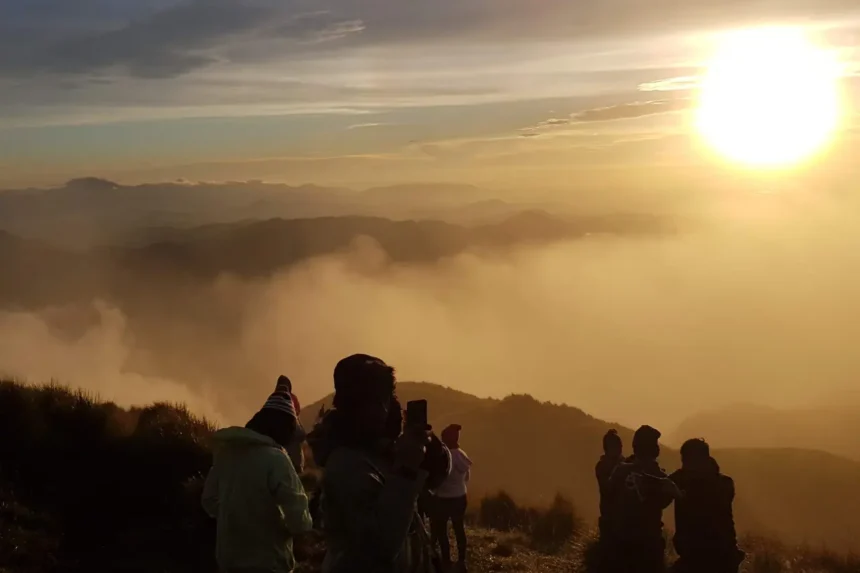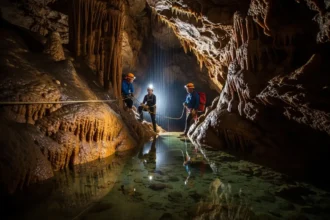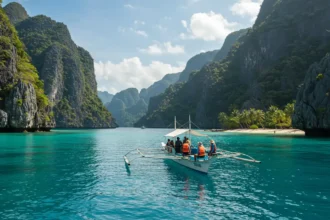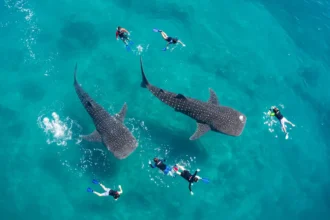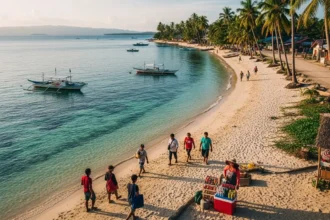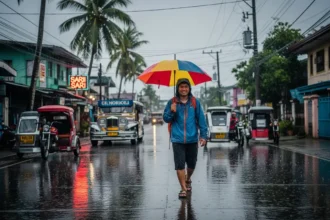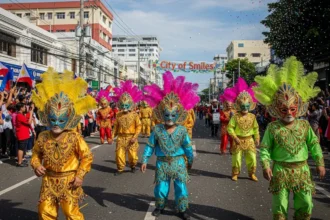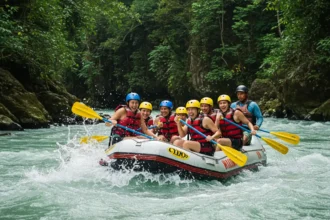There’s a reason Mount Pulag is called the Playground of the Gods. At sunrise, the summit reveals a sea of clouds that seems endless – a view so magical it makes every step, every breathless climb, completely worth it.
- 🚌 1. Getting to Mount Pulag – Location and How to Go There
- 🏕️ 2. Trail Options – Which Route to Choose (Ambangeg, Akiki, or Tawangan)
- 📋 3. Permits, Fees, and Required Orientation
- 🧤 4. What to Pack – Cold-Weather Essentials and Camping Gear
- 🌙 5. The Overnight Itinerary – What to Expect on the Trail
- ☁️ 6. The Famous “Sea of Clouds” – Best Time to Visit Mount Pulag
- 🏕️ 7. Camping at Mount Pulag – Where to Stay and Overnight Tips
- ⚠️ 8. Safety Reminders and Altitude Sickness Tips
- 💰 9. Budget Breakdown – DIY vs. Guided Tour
- 🌿 10. Responsible Hiking – Leave No Trace Principles
- ❓ FAQs About Mount Pulag Overnight Hike Guide for First-Timers
- 🌤️ Above the Clouds, Beyond Yourself
- 🧭 References
Rising between Benguet, Ifugao, and Nueva Vizcaya, Mt. Pulag is Luzon’s highest peak and one of the coldest places in the country. The air bites, the grass glows gold under morning light, and for a moment, everything feels still and sacred.
But before you chase that dream view, know this: Pulag isn’t your usual weekend hike. You’ll need permits, proper gear, and a bit of grit to conquer its freezing nights and steep trails.
This guide covers everything you need – from how to get there and what to pack, to camp rules and safety reminders – so your Mount Pulag overnight hike becomes an adventure you’ll never forget.
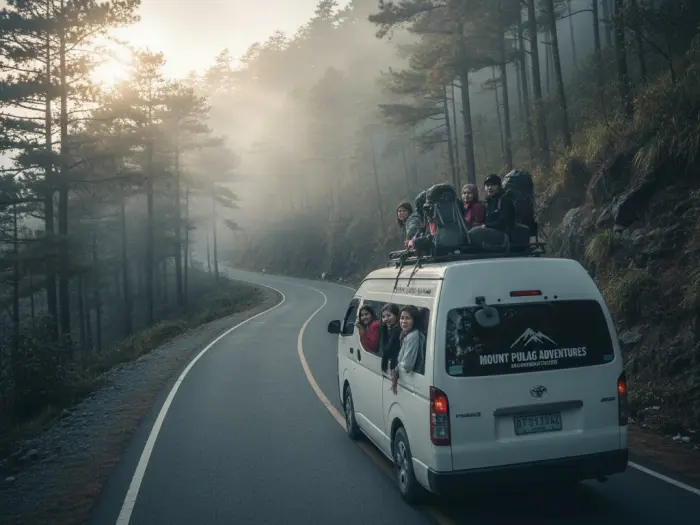
🚌 1. Getting to Mount Pulag – Location and How to Go There
Mount Pulag sits at the heart of the Cordillera mountain range, straddling the provinces of Benguet, Ifugao, and Nueva Vizcaya. Most hikers enter through Kabayan, Benguet, where the DENR (Department of Environment and Natural Resources) Visitor Center is located – your first stop for registration and orientation.
🚗 From Manila
The most common route is via Baguio City. From Manila, take a bus bound for Baguio (Victory Liner or Genesis JoyBus). The trip takes around 5–6 hours. From Baguio, you can rent a van or jeepney to Kabayan, Benguet, which takes another 3–4 hours depending on the weather and road conditions.
| Route Option | Estimated Travel Time | Notes |
|---|---|---|
| Manila → Baguio (by bus) | 5–6 hours | Victory Liner, JoyBus (₱600–₱900 one way) |
| Baguio → DENR Visitor Center (Kabayan) | 3–4 hours | Van or jeepney rental (₱7,000–₱8,000 per group) |
| DENR → Ranger Station (Ambangeg Trail jump-off) | 1 hour | Local 4×4 or jeep ride (₱1,000–₱1,500 per group) |
If you’re coming from North Luzon, you can also reach Kabayan through Ambuklao Road or Bokod, though the roads can be narrow and winding – best reserved for experienced drivers or guided trips.
🗺️ Local Hack
Most hikers spend a night in Baguio first to acclimate to the cold and buy last-minute supplies at Session Road or Burnham Park area. Remember – Mt. Pulag can drop to near-freezing temperatures, so layering up starts even before the climb.
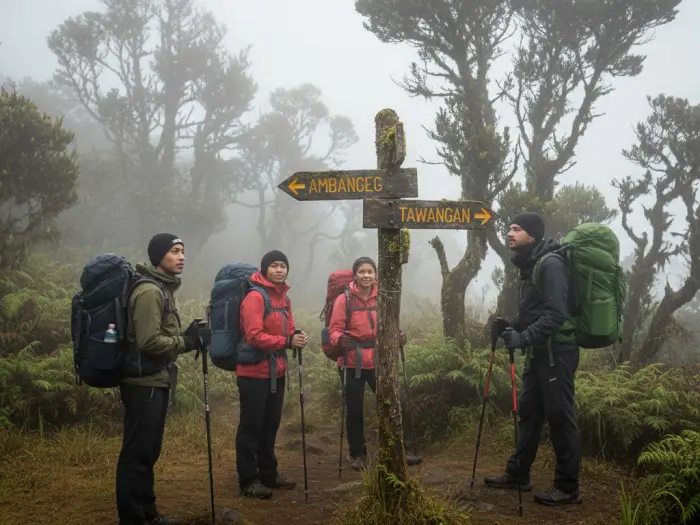
🏕️ 2. Trail Options – Which Route to Choose (Ambangeg, Akiki, or Tawangan)
Mount Pulag has several entry trails – each with its own charm, difficulty, and personality. Whether you’re a beginner or a seasoned hiker, choosing the right trail can make or break your Pulag experience.
🌄 Ambangeg Trail – The Beginner’s Route
Nicknamed the “Easy Trail” or “Executive Trail,” Ambangeg is the most popular route for first-timers. It’s relatively gradual, scenic, and beginner-friendly, with well-established campsites and rest stops.
- Start point: Ranger Station (Kabayan, Benguet)
- Difficulty: 3/9 (moderate)
- Hike time: 4–5 hours ascent, 3 hours descent
- Highlight: Rolling grasslands, sea of clouds at sunrise
- Ideal for: First-time climbers, group hikes, and guided tours
This route is perfect if you want the classic Pulag experience – breathtaking sunrise views without extreme exhaustion.
🥶 Akiki Trail – The Killer Trail
For experienced hikers seeking challenge, Akiki Trail is steeper and colder. Locals call it the “Killer Trail” for its unrelenting ascent and thin mountain air. It passes through mossy forests, pine ridges, and cold winds that bite through layers of clothing.
- Start point: Kabayan Barrio
- Difficulty: 7/9 (hard)
- Hike time: 7–9 hours ascent
- Highlight: Dense pine forests and raw mountain solitude
- Ideal for: Experienced trekkers, endurance climbers
Some hikers ascend through Akiki and descend via Ambangeg – the best of both worlds for those who want challenge and comfort combined.
🌿 Tawangan Trail – The Remote Wilderness
The Tawangan Trail is rarely used but offers untouched scenery for hardcore adventurers. It’s muddy, leech-infested, and physically demanding, but rewards hikers with pristine mossy forests and a sense of isolation you won’t find elsewhere.
- Start point: Tawangan Barangay Hall
- Difficulty: 8/9 (very hard)
- Hike time: 9–11 hours ascent
- Highlight: Remote terrain, rare flora, and fewer crowds
- Ideal for: Experienced hikers, nature purists
| Trail Name | Difficulty Level | Hiking Hours (Ascent) | Best For |
|---|---|---|---|
| Ambangeg | Moderate | 4–5 hours | Beginners & group tours |
| Akiki | Hard | 7–9 hours | Experienced climbers |
| Tawangan | Very Hard | 9–11 hours | Advanced trekkers |
⛰️ Traveler’s Move
If it’s your first Mount Pulag overnight hike, go for Ambangeg Trail. It’s scenic, safe, and the easiest way to catch the sea of clouds without pushing your limits. You’ll still feel the cold, the thrill, and the magic – just without the blisters.
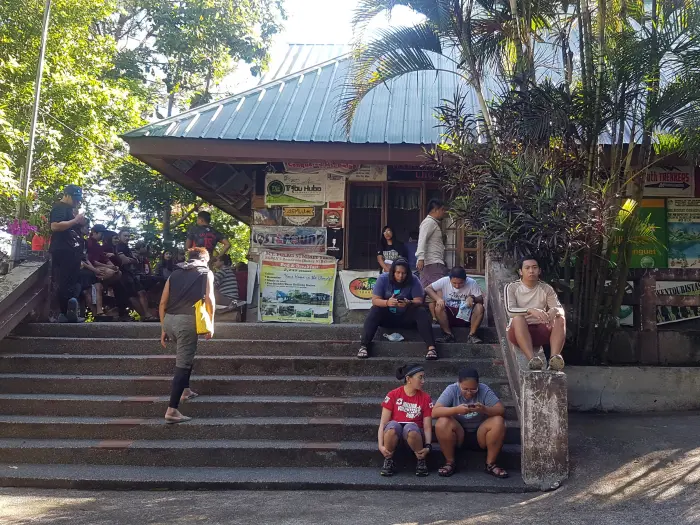
📋 3. Permits, Fees, and Required Orientation
Before setting foot on Mount Pulag, every hiker – beginner or pro – must secure permits and attend the mandatory orientation by the Department of Environment and Natural Resources (DENR). It’s not just a formality – it’s for your safety and the mountain’s protection.
🏞️ Where to Secure Your Permit
All climbers must register at the DENR Visitor Center in Ambangeg, Kabayan, Benguet. This is where you’ll sign waivers, pay environmental fees, and attend a short briefing on trail etiquette, weather conditions, and Leave No Trace policies.
You can book your slot in advance through:
- Official DENR Office (Kabayan, Benguet)
- Accredited tour operators (many handle all permits for you)
No hiker is allowed to enter Mount Pulag without a confirmed slot and orientation certificate – checkpoints along the trail strictly verify these.
💸 Estimated Fees (as of 2025)
| Fee Type | Estimated Cost (₱) | Notes |
|---|---|---|
| Environmental Fee | ₱150 per person | Required for all climbers |
| Camping Fee | ₱50–₱100 | Varies by campsite |
| Guide Fee | ₱600–₱800 per group (up to 5 pax) | Mandatory |
| Porter Fee | ₱500–₱800 per day | Optional but helpful for heavy packs |
| 4×4 Ride to Ranger Station | ₱1,000–₱1,500 per group | Round-trip |
🧭 Orientation Details
The DENR briefing lasts about 30–45 minutes. Topics include:
- Proper waste disposal and “pack in, pack out” policy
- Trail safety and first aid reminders
- Respect for local Ibaloi and Kalanguya communities
- Why bonfires, loud music, and littering are strictly prohibited
📅 Timing Trick
Book your permit weeks in advance, especially during peak months (December to February). Slots fill up fast since Pulag limits daily visitors to protect the fragile grasslands.
Without the permit, you’ll be turned away – no matter how far you’ve traveled. So handle this early and avoid the heartbreak of being stopped at the gate.
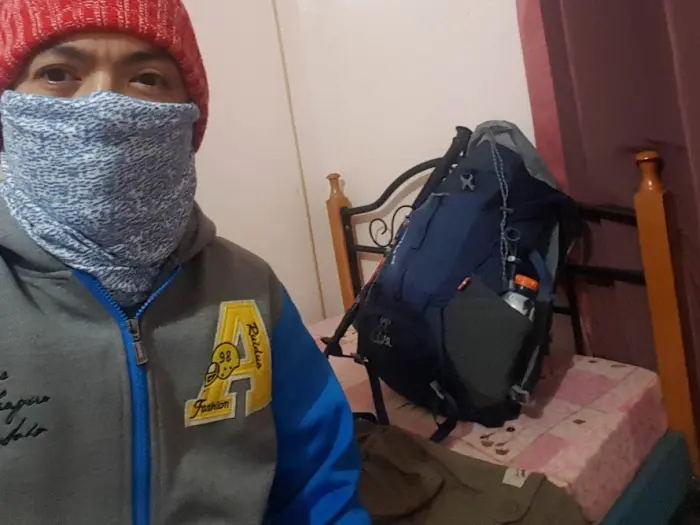
🧤 4. What to Pack – Cold-Weather Essentials and Camping Gear
If there’s one thing every Pulag veteran will tell you, it’s this: “Don’t underestimate the cold.” Temperatures at the summit can drop to 0°C or below – sometimes even frost forms on the grass at dawn. Packing smart can make the difference between a magical night and a miserable one.
🏕️ Essential Hiking & Camping Gear
| Item | Purpose | Notes / Tips |
|---|---|---|
| Backpack (40–50L) | Carries all gear | Should have rain cover |
| Sleeping Bag (rated for 0°C) | Keeps you warm | Must-have – no exceptions |
| Tent with Rainfly | Shelter | Weather can change fast |
| Ground Mat or Sleeping Pad | Insulation | Prevents cold from seeping through |
| Trekking Shoes / Boots | Traction | Must be waterproof |
| Hiking Poles | Support | Helps with long ascents |
| Headlamp / Flashlight | Night use | Bring extra batteries |
🧥 Clothing & Layering
Pulag’s weather is unpredictable – sunny one moment, foggy and freezing the next. Dress in layers you can easily adjust:
- Base layer: Dry-fit or thermal top (keeps sweat off skin)
- Mid layer: Fleece or light jacket for warmth
- Outer layer: Windbreaker or waterproof shell
- Bottoms: Thermal leggings or jogging pants
- Accessories: Beanie, gloves, neck gaiter, thick socks
🍜 Food & Personal Items
Bring light but energy-rich meals – instant noodles, rice meals, canned goods, or trail snacks like nuts and chocolate.
Don’t forget:
- Reusable water bottle (1.5–2L minimum)
- Toiletries and wet wipes
- First-aid kit and medicine
- Garbage bags (for your trash – Leave No Trace!)
🧭 Local Hack
Pack your clothes inside plastic bags before putting them in your backpack. Even if your bag gets wet, your dry clothes will save you later. And if you’re joining a tour, most have porters available – use them wisely, especially for tents and shared cooking gear.
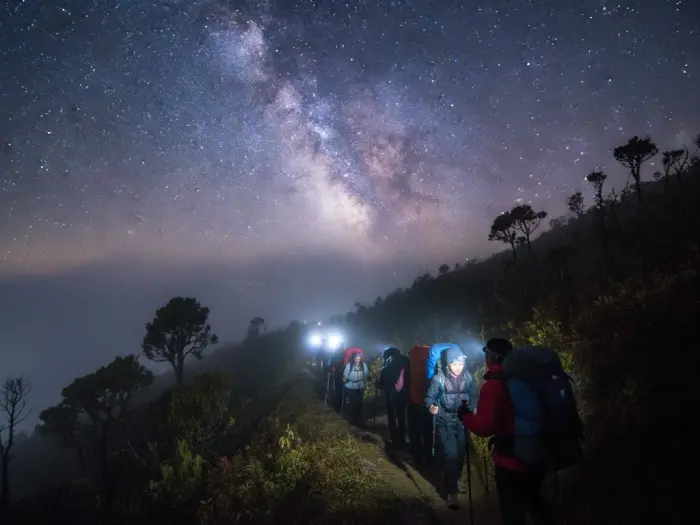
🌙 5. The Overnight Itinerary – What to Expect on the Trail
Climbing Mount Pulag is more than just a hike – it’s a journey through villages, pine forests, mossy woods, and rolling grasslands that lead you straight to the clouds. For most first-timers, the Ambangeg Trail is the safest and most scenic choice for an overnight adventure.
Here’s what a typical 2-day / 1-night Mount Pulag itinerary looks like:
| Time / Day | Activity | Details |
|---|---|---|
| Day 1 (Morning) | Travel to Kabayan, Benguet | Arrive at DENR Visitor Center for registration and orientation |
| Day 1 (Noon) | Ride to Ranger Station | 1-hour 4×4 ride; final prep before the hike |
| Day 1 (Afternoon) | Start trek via Ambangeg Trail | 4–5 hours trek to Camp 2 |
| Day 1 (Evening) | Arrive at Camp 2 / Set up tent | Early dinner, rest, lights out by 8 PM |
| Day 2 (2:00 AM) | Wake-up call for summit assault | 1.5–2 hours climb to summit |
| Day 2 (5:00 AM) | Sea of Clouds viewing at summit | Watch sunrise and take photos |
| Day 2 (7:00 AM) | Descend back to Camp 2 | Breakfast, pack up, and head down |
| Day 2 (11:00 AM) | Return to Ranger Station | End of trek, wash up, and travel back to Baguio |
🌤️ Trail Experience
The first part of the trail winds through farmlands and pine trees, followed by mossy forest paths blanketed with ferns and mist. As you near Camp 2, the trees give way to wide, open grasslands, where you’ll see the first hints of the famous sea of clouds.
The final push to the summit (around 2 hours) is done before dawn – cold, dark, and often windy. But once the sun rises above the horizon, and the golden light spills over the rolling hills, every step feels worth it.
🕯️ Traveler’s Move
Sleep early and keep your headlamp ready – the summit climb starts at 2 AM sharp. Bring hot coffee or chocolate in a thermos – it’s a small comfort that makes the freezing wait for sunrise absolutely magical.
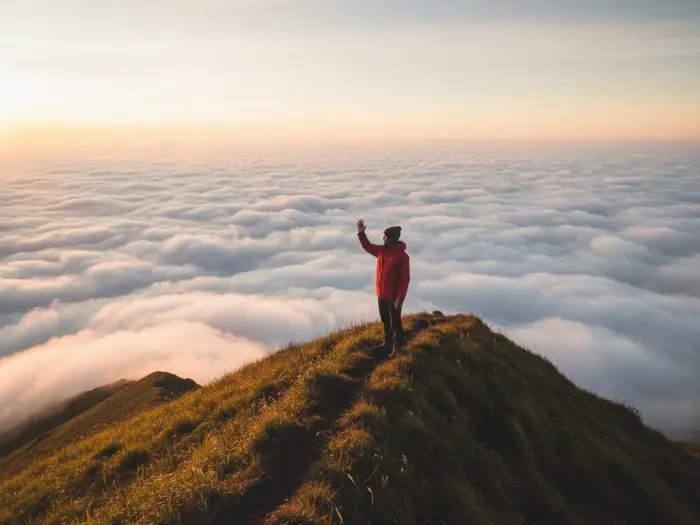
☁️ 6. The Famous “Sea of Clouds” – Best Time to Visit Mount Pulag
If there’s one reason hikers dream of Mount Pulag, it’s this – the sea of clouds. Standing on the summit at dawn, you’ll see a blanket of mist rolling gently over the valleys, glowing gold as the sun rises. It’s quiet, surreal, and feels almost spiritual – a moment where time slows and every breath reminds you how small yet alive you are.
🌄 Best Season to See the Sea of Clouds
The sea of clouds appears most clearly during the dry months of November to March, when the skies are clear and the air is crisp. During this time, temperatures can drop below zero at night, so bring proper cold-weather gear.
Avoid climbing in June to September, as this is the rainy season – trails become muddy, visibility drops, and trips are often canceled due to safety restrictions.
| Month | Weather Condition | Chance of Cloud View |
|---|---|---|
| November – February | Cold and clear | ⭐⭐⭐⭐⭐ Excellent |
| March – May | Warm but clear | ⭐⭐⭐⭐ Good |
| June – September | Rainy and foggy | ⭐ Mostly hidden |
| October | Transition month | ⭐⭐⭐ Fair |
📸 Timing Trick
To catch the best view, reach the summit before 5:30 AM. The sea of clouds usually lasts until around 7:00 AM, when the sun gets too strong. Stay long enough to watch it shift and thin – that slow fade is just as magical as the first reveal.
🌤️ Local Hack
Bring a lightweight jacket to the summit – it’s colder than you think. And don’t forget extra camera batteries; the cold drains power fast, and you don’t want your phone dying just when the sky turns gold.
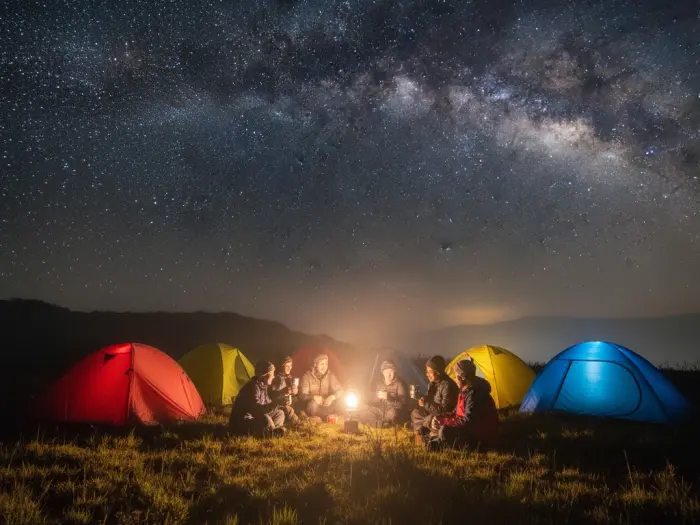
🏕️ 7. Camping at Mount Pulag – Where to Stay and Overnight Tips
Camping on Mount Pulag is an experience unlike any other – a mix of freezing temperatures, star-filled skies, and pure silence broken only by the wind sweeping through the grass. It’s here, above the clouds, that most hikers realize why Pulag is called sacred by locals.
⛺ Campsites and Overnight Setup
There are two main camping areas along the Ambangeg Trail:
| Campsite | Elevation (masl) | Distance from Summit | Description |
|---|---|---|---|
| Camp 1 | ~2,700m | 3–4 hrs from summit | Small, forested area, great for first-timers |
| Camp 2 | ~2,900m | 1.5–2 hrs from summit | Wide open grassland, colder but with a stunning view |
Most hikers camp at Camp 2 – it’s closer to the summit, ideal for catching the sea of clouds at sunrise. However, it’s also much colder, so be prepared for icy winds at night.
🧣 Camping Tips for First-Timers
- Double-layer your tent. The wind can be brutal – secure your pegs tightly.
- Sleep in full layers. Thermal tops, gloves, and thick socks are non-negotiable.
- Keep electronics inside your sleeping bag. The cold can kill batteries overnight.
- Bring a thermal flask. Hot drinks are your best friend when it drops near freezing.
- No bonfires allowed. The DENR strictly prohibits open fires to protect the grasslands.
🌌 Traveler’s Move
Step out of your tent around 8 PM and look up – the night sky here is unreal. On clear nights, you’ll see the Milky Way arching above the peaks. It’s one of the few places left in the Philippines where you can still see the stars this bright.
Camping in Mount Pulag isn’t luxurious – it’s cold, rough, and humbling. But it’s also healing. There’s something about sitting by your tent, wrapped in layers, sipping hot coffee under a thousand stars that makes you forget the world below.
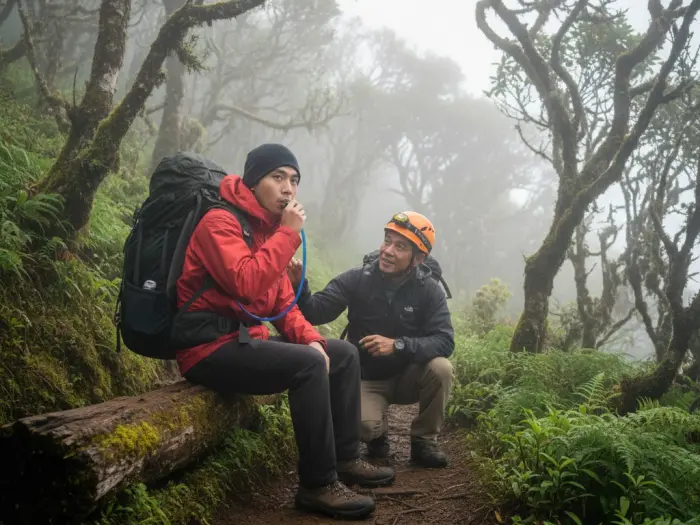
⚠️ 8. Safety Reminders and Altitude Sickness Tips
Mount Pulag may be breathtaking, but it’s also one of the most physically demanding climbs for beginners. The thin air, unpredictable weather, and high altitude can catch even seasoned hikers off guard – that’s why proper safety prep is non-negotiable.
🧭 Before the Climb
- Get enough sleep. Exhaustion and lack of rest increase your risk of altitude sickness.
- Eat light but steady. Avoid heavy, oily meals before the trek; go for rice, soup, or bananas for easy energy.
- Acclimate in Baguio overnight. Spending a night there helps your body adjust to colder, thinner air before heading to Kabayan.
🫁 During the Hike
- Take it slow. If you feel dizzy, nauseated, or light-headed, rest immediately.
- Stay hydrated. Sip small amounts often – don’t gulp.
- Don’t overlayer. Sweat can chill you fast once the temperature drops.
- Listen to your guide. Weather can turn quickly; follow instructions if they call off summit assaults due to wind or fog.
| Symptom | What It Means | What to Do |
|---|---|---|
| Headache / nausea | Mild altitude sickness | Rest, hydrate, breathe slowly |
| Dizziness / fatigue | Oxygen drop | Stop climbing, descend slightly |
| Shortness of breath / confusion | Severe reaction | Inform guide, descend ASAP |
💨 Traveler’s Move
If you’re prone to motion or altitude sickness, bring Bonamine or Diamox (after consulting a doctor). Locals also swear by salabat (ginger tea) – it helps with dizziness and warms you up during the cold ascent.
🚫 Important Safety Rules
- No smoking or alcohol before or during the hike – both worsen dehydration.
- No littering – the DENR enforces strict “pack in, pack out” rules.
- Don’t go off-trail – the grasslands are fragile, and straying damages the ecosystem.
Remember, Pulag isn’t a race. The goal is not just to reach the summit – it’s to come back safely.
💰 9. Budget Breakdown – DIY vs. Guided Tour
Whether you’re hiking solo or joining a tour group, knowing your budget early helps you plan smarter. A Mount Pulag overnight hike can range from ₱3,000 to ₱6,000 depending on your travel style, group size, and trail choice.
🚐 Option 1: Join a Guided Tour (Recommended for First-Timers)
Most beginners join organized tours from Manila or Baguio. These packages include transport, permits, guide fees, and even tents – perfect if you want convenience without worrying about logistics.
| Expense | Estimated Cost (₱) | Notes |
|---|---|---|
| Round-trip van (Manila–Benguet) | 2,000–2,500 | Usually included in package |
| DENR permit + environmental fees | 150–200 | Handled by the organizer |
| Guide + porter fees | 200–400 | Shared among group |
| Tent + meal rental (optional) | 300–500 | Some packages include this |
| Total (all-in package) | ₱3,500–₱4,500 | Hassle-free, great for first-timers |
🥾 Option 2: DIY (Do-It-Yourself) Climb
If you prefer flexibility, a DIY climb gives you more control – but also more coordination. You’ll handle transport, permits, and equipment yourself.
| Expense | Estimated Cost (₱) | Notes |
|---|---|---|
| Bus Manila → Baguio (RT) | 1,200–1,800 | Victory Liner / JoyBus |
| Van Baguio → Kabayan (RT) | 1,400–1,600 | Split among group |
| DENR + campsite + guide fees | 800–1,000 | Mandatory |
| Food + water + gas share | 500–700 | Bring packed meals |
| Miscellaneous + souvenirs | 300–500 | Optional |
| Total (DIY group of 5) | ₱4,000–₱5,000 | Slightly higher but flexible |
🎒 Budget Move
If you’re a first-timer, join a small guided group (10 pax or less). You’ll save on transport, have experienced guides, and still enjoy a semi-DIY vibe. For couples or barkadas, that’s the best balance between cost and comfort.
🏧 Extra Tip
Bring small bills – most vendors at DENR, ranger stations, and local stores don’t have change for ₱1,000 notes. And always keep some cash for souvenirs like Mt. Pulag patches or local delicacies like ube jam and tinawon rice.
🌿 10. Responsible Hiking – Leave No Trace Principles
Mount Pulag is not just a hiking destination – it’s a sacred ancestral mountain for the Ibaloi, Kalanguya, and Kankanaey tribes who believe spirits guard its peaks. That’s why every climber is expected to practice Leave No Trace (LNT) ethics – protecting both nature and culture while enjoying the beauty of the trail.
🏞️ The 7 Leave No Trace Principles
| Principle | Meaning in Practice |
|---|---|
| 1️⃣ Plan Ahead and Prepare | Secure permits, check weather, and pack light to reduce waste. |
| 2️⃣ Travel and Camp on Durable Surfaces | Stick to the designated trails and campsites – avoid trampling grasslands. |
| 3️⃣ Dispose of Waste Properly | Walang iwanan. Bring trash bags and take everything back down – even tissue. |
| 4️⃣ Leave What You Find | Don’t pick flowers, plants, or stones. Leave the mountain exactly as you found it. |
| 5️⃣ Minimize Campfire Impact | Campfires are banned. Use portable stoves or shared cooking gear instead. |
| 6️⃣ Respect Wildlife | Don’t feed animals or disturb their natural habitat. |
| 7️⃣ Be Considerate of Other Visitors | Keep noise down, especially at night. Let everyone enjoy the peace of Pulag. |
🫶 Local Respect
Before starting your climb, many local guides perform a short prayer or gesture to honor the spirits of the mountain. It’s not superstition – it’s respect. Join them quietly, and remember that you’re walking on sacred ground.
🧭 Traveler’s Move
Bring a small eco-bag to collect any trash you see along the way – even if it’s not yours. The locals will appreciate it, and it’s the kind of act that keeps Pulag’s magic alive for future hikers.
Because the truth is simple: we don’t climb mountains to conquer them – we climb to understand them.
❓ FAQs About Mount Pulag Overnight Hike Guide for First-Timers
- What is the best trail for beginners climbing Mount Pulag?
The Ambangeg Trail is the easiest route for first-timers. It’s scenic, beginner-friendly, and part of most Mount Pulag overnight hike guides approved by the DENR. - How long does it take to reach the Mount Pulag summit?
From the Ranger Station via Ambangeg Trail, expect around 4–5 hours ascent and 3 hours descent. The trek is moderate and ideal for those new to mountain hiking. - What permits are needed for a Mount Pulag DIY hike?
You must register at the DENR Visitor Center Kabayan, Benguet, pay environmental fees, and attend an orientation before hiking Mount Pulag – no exceptions. - When is the best time to climb Mount Pulag to see the sea of clouds?
Visit between November and March, when skies are clear and the iconic Mt Pulag sea of clouds is most visible at sunrise. - How cold does it get during an overnight camp at Mount Pulag?
Temperatures can drop to 0 °C or lower, so bring thermal wear, gloves, and a sleeping bag rated for sub-zero nights at Camp 2. - How difficult is the Mount Pulag Ambangeg Trail for first-time climbers?
It’s rated 3 / 9 difficulty – moderately easy. The trail is gradual with resting spots, perfect for beginners seeking the sea of clouds experience without extreme strain. - What should I pack for the Mount Pulag overnight camping trip?
Bring layers, waterproof boots, a 0 °C sleeping bag, tent, and energy food. For a full checklist, follow the Mount Pulag overnight hike guide packing list in this article. - Do I need a guide or porter when hiking Mount Pulag?
Yes – local guides are mandatory, and hiring a porter is highly recommended for carrying tents and shared gear on steep sections of Mt Pulag’s Ambangeg Trail. - How much is the total budget for a Mount Pulag overnight hike?
Expect to spend ₱3,500–₱5,000, depending on whether you join a tour or go DIY. Costs include permits, transport, and campsite fees. - Is Mount Pulag open year-round for hiking?
The park is open most of the year but may close during heavy rain or typhoon months (June–September) for safety and trail preservation. Always confirm with the DENR Kabayan office before traveling.
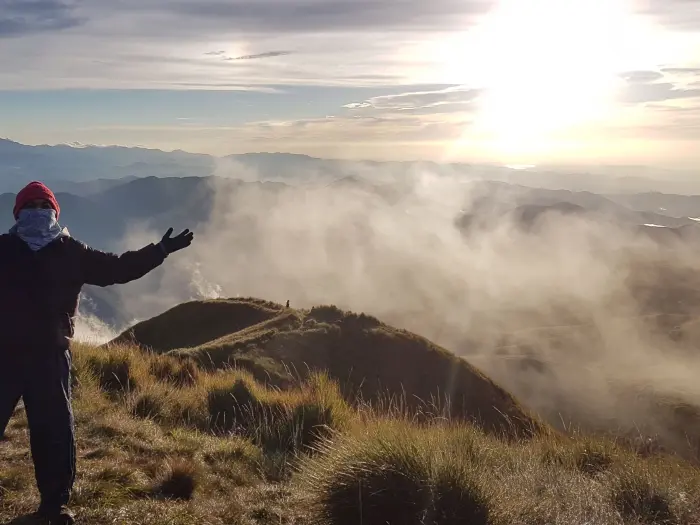
🌤️ Above the Clouds, Beyond Yourself
Climbing Mount Pulag isn’t just about chasing the sea of clouds – it’s about discovering what you’re capable of when you step out of comfort and into the wild. Every steep step, every breath of cold mountain air, and every shiver under the stars teaches you something about patience, gratitude, and grit.
You’ll hear your heartbeat echo in the silence of the mossy forest. You’ll see the sky turn gold from the summit. And as the clouds part below your feet, you’ll realize that this mountain isn’t conquered – it’s shared with every soul brave enough to climb it.
For many Filipinos, Pulag is more than a destination. It’s a reminder that beauty takes effort, that peace is earned through struggle, and that even the hardest climbs are worth it once the sun rises.
So when you finally stand there – breathless, freezing, but smiling – remember: it’s not just the view that matters. It’s the journey, the people you met on the trail, and the part of you that grew stronger along the way.
Because the truth is simple: you didn’t just reach Mount Pulag’s peak – you reached your own.
🧭 References
- Guide to the Philippines – Mt. Pulag Hiking Tours & Info
- Project Gora – Mt. Pulag: Itinerary & Trail Guide
- Lazy Camper PH – Mt. Pulag: Where My Hiking Journey Started
- Vista Residences – Best Time to Go to Mount Pulag
- DENR Official Account for Mount Pulag (Permits & Guidelines)



